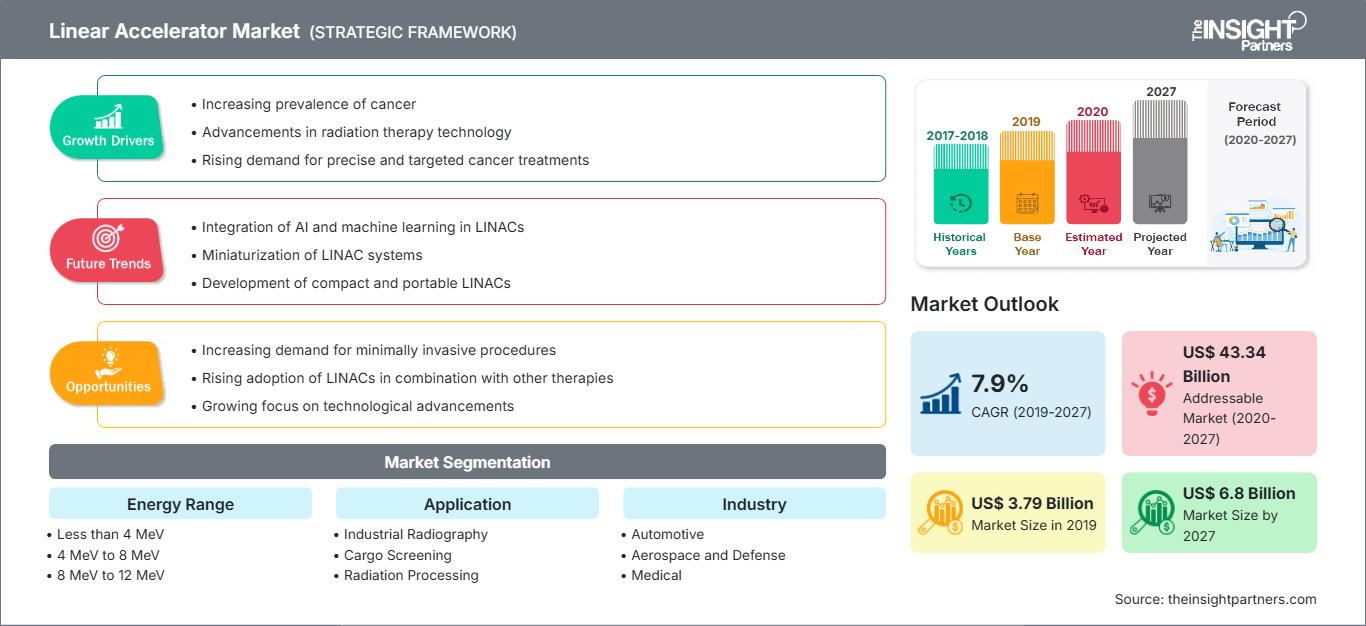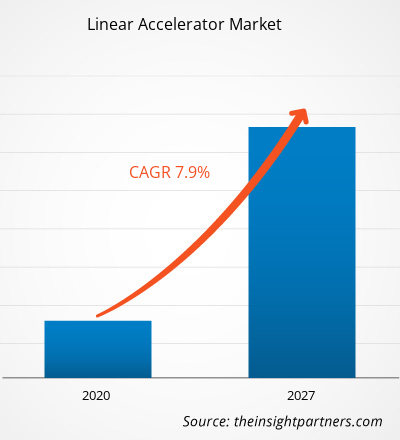[Informe de investigación] El mercado de aceleradores lineales se valoró en 3.787,9 millones de dólares estadounidenses en 2019 y se espera que alcance los 6.803,7 millones de dólares estadounidenses en 2027; se estima que crecerá a una tasa de crecimiento anual compuesta (TCAC) del 7,9% durante el período 2020-2027.CAGR of 7.9% during 2020–2027.
Los aceleradores lineales (LINAC) se utilizan ampliamente en la industria médica para el tratamiento del cáncer. El cáncer es la segunda causa principal de muerte a nivel mundial y tiene un impacto económico significativo. En 2018, la Organización Mundial de la Salud (OMS), a través de su agencia de investigación sobre el cáncer, la Agencia Internacional para la Investigación del Cáncer (IARC), estimó un aumento de 18,1 millones de casos nuevos y 9,6 millones de muertes. El envejecimiento de la población, el crecimiento poblacional y los cambios en los factores económicos y sociales que influyen en ciertas causas del cáncer son los principales factores que contribuyen al aumento de la carga de esta enfermedad. Además, la mayoría de los casos de cáncer se diagnostican en etapas avanzadas. Por lo tanto, a medida que aumenta la incidencia del cáncer, crece la necesidad de una atención oncológica rentable, lo que a su vez ha impulsado importantes inversiones en tecnologías de vanguardia para desarrollar nuevas opciones de tratamiento en todo el mundo. Algunos de los centros oncológicos tecnológicamente más avanzados del mundo, que desarrollan constantemente productos y servicios avanzados para el tratamiento de pacientes con cáncer, incluyen el Servicio Oncológico Macarthur (Australia), el Hospital Oncológico James y el Instituto de Investigación Solove (EE. UU.), el Instituto de Oncología Vall d'Hebron (España), el Centro Oncológico de Townsville (Australia), los Hospitales Apollo, el Centro Oncológico Integral de la Universidad de Chicago (EE. UU.), el Centro Nacional de Investigaciones Oncológicas (CNIO) de España, el Christie Hospital NHS Foundation Trust (Reino Unido), el Centro Oncológico Princess Margaret (Canadá), el Centro Oncológico Abramson (EE. UU.), el Instituto Oncológico de los Países Bajos y el Centro Oncológico Adventista de Hong Kong.
Los aceleradores desempeñan un papel fundamental en la atención médica moderna. Los aceleradores lineales médicos utilizan rayos X de alta energía para destruir células cancerosas y tumores, preservando los tejidos sanos adyacentes. Los LINAC se consideran dispositivos innovadores que han revolucionado el tratamiento del cáncer gracias a su rentabilidad. Además, el mercado ha experimentado un cambio significativo en el tratamiento del cáncer, con una creciente preferencia por los procedimientos no invasivos en lugar de los invasivos. El tratamiento no invasivo incluye la radioterapia, la opción más rentable y avanzada, que puede aplicarse para tratar una amplia gama de cánceres, sola o en combinación con quimioterapia, cirugía y otros procedimientos.
Obtendrá personalización gratuita de cualquier informe, incluyendo partes de este informe, análisis a nivel de país y paquetes de datos de Excel. Además, podrá aprovechar excelentes ofertas y descuentos para empresas emergentes y universidades.
Mercado de aceleradores lineales: Perspectivas estratégicas

-
Obtenga las principales tendencias clave del mercado que se describen en este informe.Esta muestra GRATUITA incluirá análisis de datos, que abarcarán desde tendencias de mercado hasta estimaciones y pronósticos.
Impacto de la pandemia de COVID-19 en el mercado de aceleradores lineales
Según el último informe de situación de la Organización Mundial de la Salud (OMS), Estados Unidos, España, Italia, Francia, Alemania, Reino Unido, Rusia, Turquía, Brasil, Irán y China se encuentran entre los países más afectados por el brote de COVID-19. El brote se inició en Wuhan (China) en diciembre de 2019 y, desde entonces, se ha propagado rápidamente por todo el mundo. Según las últimas cifras de la OMS, con fecha del 30 de junio de 2020, hay aproximadamente 10,18 millones de casos confirmados de COVID-19 a nivel mundial, con cerca de 503.862 fallecimientos, y el número de casos crece a ritmos diferentes en cada país. La crisis de la COVID-19 está afectando a las industrias de todo el mundo, y se prevé que la economía global sufra el mayor impacto en 2020 y 2021. El brote ha provocado importantes trastornos en sectores clave como la manufactura, el sector médico, la energía, la electrónica y los semiconductores, y la automoción. La drástica caída de la actividad industrial está afectando el crecimiento del mercado mundial de aceleradores lineales, ya que estos constituyen los principales puntos de oferta y demanda para los participantes del mercado. El cierre de fábricas, las restricciones de viaje y comercio, y el cierre de fronteras para combatir y contener el brote han impactado la fabricación, el suministro y las ventas de diversos componentes electrónicos necesarios para la producción de aceleradores lineales.
Perspectivas del mercado: Mercado de aceleradores lineales
La incorporación de tecnologías avanzadas impulsa el crecimiento del mercado de aceleradores lineales
La llegada de la inteligencia artificial (IA) y el aprendizaje automático (AA) está transformando el panorama de los dispositivos de imagen médica a nivel mundial, especialmente al aumentar la eficacia del tratamiento del cáncer mediante tecnologías como el acelerador lineal (LINAC). En consecuencia, los actores del mercado se están centrando en el desarrollo de LINAC con AA e IA para el tratamiento oncológico. Es probable que esta técnica se convierta en una opción de tratamiento conveniente en un futuro próximo. Por ejemplo, en 2019, Varian Medical Systems, Inc. lanzó su terapia Ethos, un sistema de radioterapia adaptativa con IA. Este sistema, que incluye un acelerador lineal, está diseñado para mejorar la capacidad, la flexibilidad y la eficiencia de la radioterapia. Esta nueva solución permite administrar un tratamiento adaptativo en línea en tan solo 15 minutos, desde la preparación del paciente hasta la administración del tratamiento. Asimismo, en 2018, Elekta Inc. e IBM Watson Health colaboraron en el desarrollo de soluciones digitales para la atención oncológica. Por lo tanto, se espera que la integración de tecnologías avanzadas impulse la aceptación de los aceleradores lineales en los próximos años.
Perspectivas basadas en el rango de energía
Según su rango de energía, el mercado de aceleradores lineales se segmenta en menos de 4 MeV, de 4 MeV a 8 MeV, de 8 MeV a 12 MeV y más de 12 MeV. Empresas como Manoir Industries utilizan sistemas de aceleradores lineales; la planta de Pîtres de la compañía cuenta con cinco salas de radiografía, que representan un acelerador lineal de cobalto-iridio con un rango de energía de 9 MeV.
Información basada en aplicaciones
Según su aplicación, el mercado de aceleradores lineales se segmenta en radiografía industrial, inspección de carga, procesamiento por radiación y otros. En 2019, el segmento de procesamiento por radiación lideró el mercado de aceleradores lineales en términos de tamaño. El procesamiento por radiación comprende la estimulación de reacciones químicas con radiaciones ionizantes en diferentes materiales. Incluye la modificación de materiales poliméricos, la esterilización de dispositivos médicos, el tratamiento de residuos y la conservación de alimentos.
Perspectivas basadas en la industria
Según el sector industrial, el mercado de aceleradores lineales se segmenta en automoción, aeroespacial y defensa, medicina, alimentación y bebidas, metales y minería, y otros. El sector médico es uno de los principales usuarios de aceleradores lineales para el tratamiento de pacientes con cáncer. Empresas como Elekta, Varian y Bevatech GmbH utilizan aceleradores lineales para este fin.
Los agentes del mercado se centran en la innovación y el desarrollo de nuevos productos, integrando tecnologías y características avanzadas para competir con la competencia.
- En 2019, CGN Dasheng firmó un acuerdo con Nondestructive Testing Co., Ltd. y Thailand Advanced Sterilization Company para el desarrollo de tecnología de haz de electrones. El acuerdo consta de un Memorando de Entendimiento y un pedido de venta de aceleradores de electrones para respaldar la construcción de un Centro de Investigación de Aplicaciones de Aceleradores de Electrones en Tailandia.
- En 2019, Altair Technologies, Inc., proveedor de aceleradores lineales (LINAC), anunció el lanzamiento de su sitio web para atender a diversas industrias, como la médica, la de semiconductores, la de seguridad, la de defensa y la aeroespacial. El lanzamiento del nuevo sitio web refleja la comprensión y el compromiso de garantizar que el desempeño empresarial esté en consonancia con las expectativas de sus clientes.
Mercado de aceleradores lineales – Por rango de energía
- Menos de 4 MeV
- De 4 MeV a 8 MeV
- De 8 MeV a 12 MeV
- Más de 12 MeV
Mercado de aceleradores lineales – Por aplicación
- Radiografía industrial
- Inspección de carga
- Procesamiento por radiación
- Otros
Mercado de aceleradores lineales – Por sector
- Automotor
- Aeroespacial y Defensa
- Médico
- Alimentos y bebidas
- Metales y minería
- Otros
Mercado de aceleradores lineales: perfiles de empresas
- Altair Technologies, Inc.
- BEVATECH GmbH
- CGN Dasheng
- diondo GmbH
- Elekta AB
- IBA
- Industrias Iotron
- Mitsubishi Heavy Industries Machinery Systems, LTD.
- Corporación de imágenes Varex
- Varian Medical Systems, Inc.
Alcance del informe
Perspectivas regionales del mercado de aceleradores lineales
Los analistas de The Insight Partners han explicado en detalle las tendencias regionales y los factores que influyen en el mercado de aceleradores lineales durante el período de previsión. Esta sección también analiza los segmentos del mercado de aceleradores lineales y su distribución geográfica en Norteamérica, Europa, Asia Pacífico, Oriente Medio y África, y Sudamérica y Centroamérica.
Alcance del informe de mercado de aceleradores lineales
| Atributo del informe | Detalles |
|---|---|
| Tamaño del mercado en 2019 | 3.790 millones de dólares estadounidenses |
| Tamaño del mercado para 2027 | 6.800 millones de dólares estadounidenses |
| Tasa de crecimiento anual compuesto global (2019 - 2027) | 7,9% |
| Datos históricos | 2017-2018 |
| período de previsión | 2020-2027 |
| Segmentos cubiertos |
Por rango de energía
|
| Regiones y países cubiertos |
América del norte
|
| Líderes del mercado y perfiles de empresas clave |
|
Densidad de los participantes en el mercado de aceleradores lineales: comprensión de su impacto en la dinámica empresarial
El mercado de aceleradores lineales está creciendo rápidamente, impulsado por la creciente demanda de los usuarios finales debido a factores como la evolución de las preferencias de los consumidores, los avances tecnológicos y una mayor conciencia de los beneficios del producto. A medida que aumenta la demanda, las empresas amplían su oferta, innovan para satisfacer las necesidades de los consumidores y aprovechan las nuevas tendencias, lo que impulsa aún más el crecimiento del mercado.

- Obtenga una visión general de los principales actores del mercado de aceleradores lineales.
- Análisis histórico (2 años), año base, pronóstico (7 años) con CAGR
- Análisis PEST y FODA
- Tamaño del mercado, valor/volumen: global, regional y nacional
- Industria y panorama competitivo
- Conjunto de datos de Excel
Informes recientes
Testimonios
Razón para comprar
- Toma de decisiones informada
- Comprensión de la dinámica del mercado
- Análisis competitivo
- Información sobre clientes
- Pronósticos del mercado
- Mitigación de riesgos
- Planificación estratégica
- Justificación de la inversión
- Identificación de mercados emergentes
- Mejora de las estrategias de marketing
- Impulso de la eficiencia operativa
- Alineación con las tendencias regulatorias






















 Obtenga una muestra gratuita para - Mercado de aceleradores lineales
Obtenga una muestra gratuita para - Mercado de aceleradores lineales